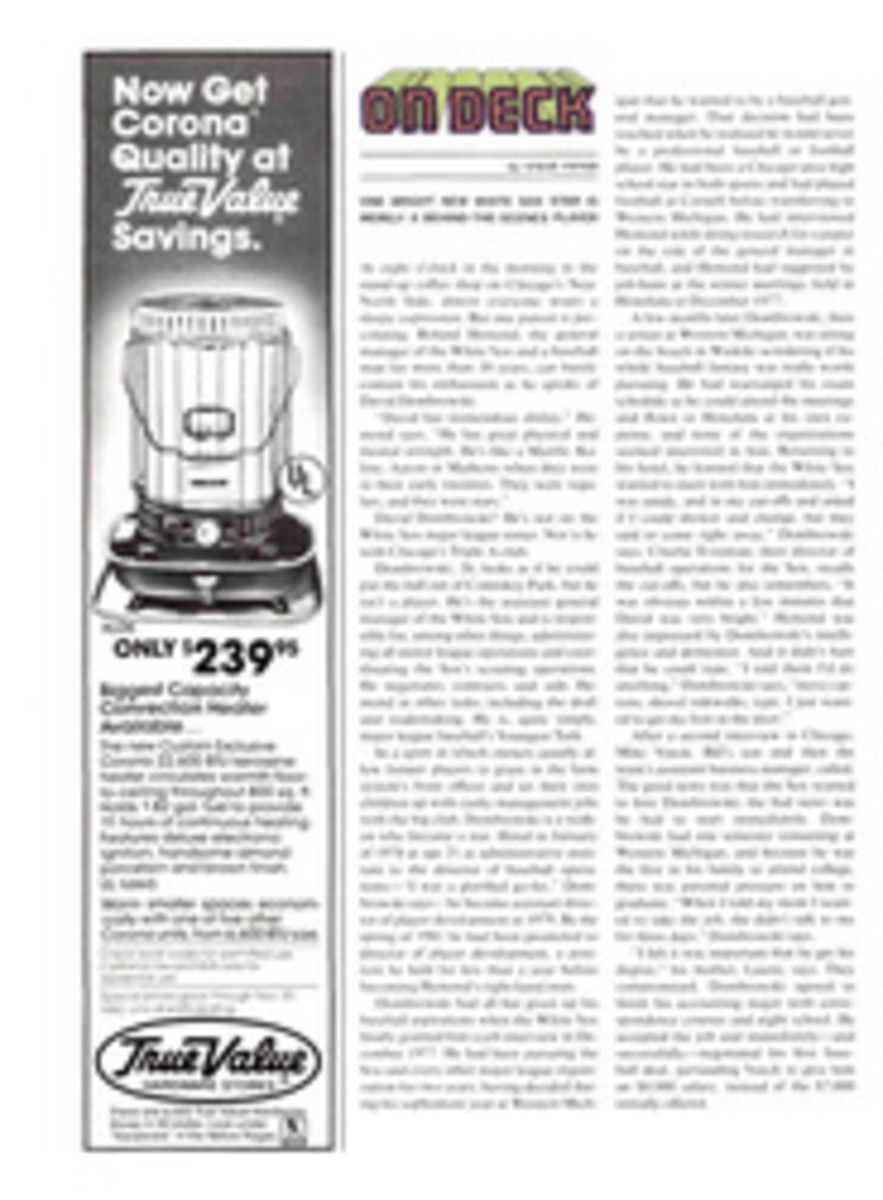
ARTHROSCOPY IS THE KINDEST CUT FOR BAD KNEES, BUT IT STILL ISN'T PERFECT
Until fairly recently, athletes had a special dread of knee injuries, because such afflictions frequently led to surgery. An operation meant a hospital stay, a surgeon slicing into the knee, months of painful and strenuous rehabilitation and a zipperlike scar for a souvenir. But since the mid-1970s, many surgeons have turned to arthroscopy, a revolutionary, though problematic, technique that can repair certain knee injuries more effectively and less traumatically than traditional surgery.
The new approach became possible with the introduction of the arthroscope, a pencil-thin telescopic instrument that's inserted into the knee through a tiny incision. At first the scope was used only to improve diagnoses, but its usefulness was soon augmented by the development of miniaturized surgical instruments that could be used in conjunction with the basic arthroscope.
Today the arsenal of arthroscopic instruments is varied and sophisticated. A surgeon can study the entire interior of the joint by penetrating the knee from several different locations and using scopes with angled optics. If he likes, he can attach a small camera to a scope for viewing the joint on a television screen. His choice of surgical instruments includes everything from grasping forceps and trimmers to motorized shavers and drills.
Arthroscopy is especially well suited to dealing with two common cartilage injuries. One involves tears of the menisci, little crescents of cartilage that are particularly vulnerable when an athlete pivots or changes direction. In open surgery a surgeon routinely removes a torn meniscus, but using arthroscopic methods he can usually remove the damaged part of the meniscus and smooth and reshape the remainder, leaving the meniscus largely intact to provide better knee stability. Any loose cartilage can readily be found and sucked out.
Arthroscopy can also relieve severe cases of chondromalacia, a roughening or softening of the cartilage lining behind the kneecap, generally caused and aggravated by bent-knee activities like jumping or skiing. A surgeon can shave the lining, and, if necessary, realign the kneecap. Less often, arthroscopy is used to reattach bone fragments with wire, clean or cut away tightened scar tissue and remove diseased cartilage from the joint surfaces.
Because these procedures don't require a major invasion of the body, as conventional knee surgery does, an arthroscopic operation is less likely to be physically and mentally traumatic. Postoperative pain, scarring and chances of complications or infection are minimal. Most patients can walk immediately after surgery and spend little or no time in the hospital. Normally they can be rehabilitated quickly and return to everyday activities within weeks. Although an arthroscopic operation costs at least 20% more than open surgery, the reduced need for hospital care and extended therapy can cut costs by as much as 50%.
The advantages of arthroscopy have been dramatically apparent in the rapid recoveries of many top athletes. Former Tight End Keith Krepfle of the Philadelphia Eagles scored his team's only touchdown in the 1981 Super Bowl; he had had knee surgery the previous month. Skier Steve Mahre recovered from arthroscopic surgery on both knees in six weeks, which enabled him to return to the slopes in time to beat Ingemar Stenmark for the 1982 world championship title in the giant slalom.
Yet Dr. John B. McGinty, president of the Arthroscopy Association of North America, warns that the popular image of arthroscopy as a fix-it-all, totally safe procedure is misleading. "There are clear limitations to what arthroscopy can do," he says, "so patients' expectations shouldn't be excessive."
Arthroscopy cannot be used to repair an advanced arthritic knee or to expose enough surface area to operate on torn ligaments.
As with open surgery, an arthroscopic operation may be only a short-term success if the patient doesn't work at his rehabilitative exercises, if any are required. Even with conscientious exercise, the average patient can't expect to recover as quickly as a well-conditioned athlete can.
Arthroscopic surgery also exposes a patient to the same unpredictable hazards of general anesthesia that accompany open surgery. A general anesthetic is used to dull the pain caused by the surgical leg tourniquet required in such operations, relax the leg muscles so the joint will move freely and allow for the slight possibility that arthroscopic techniques will fail, forcing the surgeon to cut the joint open.
The judgment and skills of the surgeon are two other worrisome areas for patients. Dr. Robert Metcalf, who is associate clinical professor of orthopedic surgery at the University of Utah, says he's worried about some of the feedback he has received. According to Metcalf, "There's considerable concern that arthroscopic surgery is being over-utilized and is sometimes being done in a manner damaging to healthy cartilage."
A prudent orthopedic surgeon adds arthroscopy to his repertoire by first learning diagnostic arthroscopy and later progressively mastering more difficult operations. This step-by-step self-teaching process is essential, because arthroscopy calls for skills different from those used in open surgery. A doctor must learn to manipulate small, easily broken instruments inside a very tight joint while watching a magnified, two-dimensional picture of the joint on a television screen. Dr. Barton Nisonson, section chief of arthroscopic surgery at New York's Lenox Hill Hospital and associate orthopedic surgeon for the New York Jets, compares the hand-eye coordination needed to do arthroscopy to "working the controls of an Atari game."
But if a surgeon lacks skills or patience, he can accidentally scar healthy cartilage or tissue by mishandling a knife or a power cutter. This could be even more of a problem when the lasers and high-speed motors, which are now considered experimental, become standard arthroscopic equipment. Says Metcalf, "With these high-energy devices a surgeon loses the tactile feedback that tells him where the softened, damaged cartilage ends and the firmer, healthy cartilage begins. He can unwittingly hit healthy cartilage and initiate an arthritic condition."
All of these uncertainties may give a candidate for surgery pause, and indeed they should. Arthroscopic surgery, when called for, is preferable to open surgery, but it still poses dangers, and it shouldn't be acceded to lightly. Arthroscopy may be the kindest cut of all, but it remains a calculated risk.

